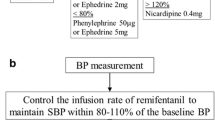Abstract
A noninvasive blood pressure monitor (Finapres) that continuously displays the arterial waveform using the Penňaz methodology has recently been introduced into clinical practice. We compared this device with an automated oscillometric blood pressure monitor (Dinamap 1846SX) in 20 patients during spinal anesthesia for nonemergency cesarean section according to a procedure suggested by the Association for the Advancement of Medical Instrumentation. After administration of the spinal anesthetic, the Finapres monitor produced systolic, mean, and diastolic pressure measurements greater than those of the Dinamap monitor (6.6±12.5, 3.3±10.4, and 7.2±9.8 mm Hg, respectively). In most patients, the Finapres measurements were similar to those determined by the Dinamap; however, in 4 patients, mean systolic differences were greater than 20 mm Hg. These patients did not differ from the others in age, height, weight, or baseline blood pressure, and the pressure values recorded by the Finapres monitor were substantially higher than those measured by auscultation in the labor room. In 30% of the patients, the offset between Dinamap and Finapres blood pressure measurements changed markedly over the course of the surgical procedure. The Finapres monitor occasionally stopped working and had to be restarted. In 1 patient (not included in this analysis), the Dinamap monitor was unable to determine the blood pressure due to patient shivering; this did not appear to interfere with the Finapres. We conclude that the Finapres monitor does not consistently provide blood pressure information equivalent to that of the Dinamap in obstetric patients undergoing spinal anesthesia. When the Finapres monitor is used, pressure measurements should be verified periodically by using an auscultatory or oscillometric blood pressure methodology to rule out the presence of large differences, particularly in systolic pressure. The extreme systolic blood pressure discrepancies noted in 20% of the patients studied warrant further evaluation.
Similar content being viewed by others
References
Peňaz J. Photoelectric measurement of blood pressure, volume and flow in the finger. Dig 10th Int Conf Biol Engl 1973;104
Boehmer RD. Continuous, real-time, noninvasive monitor of blood pressure: Penaz methodology applied to the finger. J Clin Monit 1987;3:282–287
Datta S, Alper MH, Ostheimer GW, Weiss JB. Method of ephedrine administration and nausea and hypotension during spinal anesthesia for cesarean section. Anesthesiology 1982;56:60–70
Datta S, Kitzmiller JL, Alper MH, Galins M. Maternal and fetal acid-base status following elective cesarean section under spinal anesthesia: infusion of dextrose vs. nondextrose solutions. Anesthesiology 1980;53:S305
Norris MD. Hypotension during spinal anesthesia for cesarean section: does it affect neonatal outcome? Reg Anaesth 1987;12:191–194
Association for the Advancement of Medical Instrumentation. American national standard for electronic or automated sphygmomanometers, appendix C. Arlington, VA: Association for the Advancement of Medical Instrumentation, 1987:22
Sheiner LB, Beal SL. Some suggestions for measuring predictive performance. J Pharmacokinet Biopharm 1981;9:503–512
Kurki T, Smith NT, Head N, et al. Noninvasive continuous blood pressure measurement from the finger: optimal measurement conditions and factors affecting reliability. J Clin Monit 1987;3:6–13
Smith NT, Wesseling KH, de Wit B. Evaluation of two prototype devices producing noninvasive, pulsatile calibrated blood pressure measurement from a finger. J Clin Monit 1984;1:17–29
Egmond JV, Hasenbros M, Crul JF. Invasive v. noninvasive measurement of arterial pressure. Br J Anaesth 1985;57:434–444
Hutton P, Dye J, Prys-Roberts C. An assessment of the Dinamap 845. Anaesthesia 1984;39:262–267
Dorlas JC, Nijboer JA, Butijn WT, et al. Effects of peripheral vasoconstriction on the blood pressure in the finger, measured continuously by a new noninvasive method (the FinapresR). Anesthesiology 1985;62:342–345
Bruner JMR, Krenis LJ, Kunsman JM, Sherman AP. Comparison of direct and indirect methods of measuring arterial blood pressure. Med Instrum 1981;15:11–21
Hamilton WF, Dow P. An experimental study of the standing waves in the pulse propagated through the aorta. Am J Physiol 1939;125:48–59
Loubser PG. Comparing direct and indirect arterial blood pressure (letter). Anesthesiology 1985;63:566–569
Author information
Authors and Affiliations
Rights and permissions
About this article
Cite this article
Epstein, R.H., Kaplan, S., Leighton, B.L. et al. Evaluation of a continuous noninvasive blood pressure monitor in obstetric patients undergoing spinal anesthesia. J Clin Monitor Comput 5, 157–163 (1989). https://doi.org/10.1007/BF01627447
Received:
Revised:
Accepted:
Issue Date:
DOI: https://doi.org/10.1007/BF01627447




